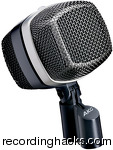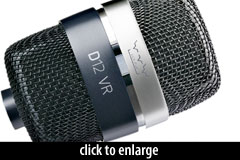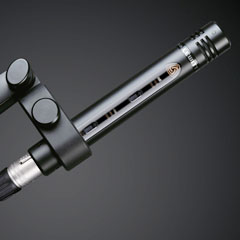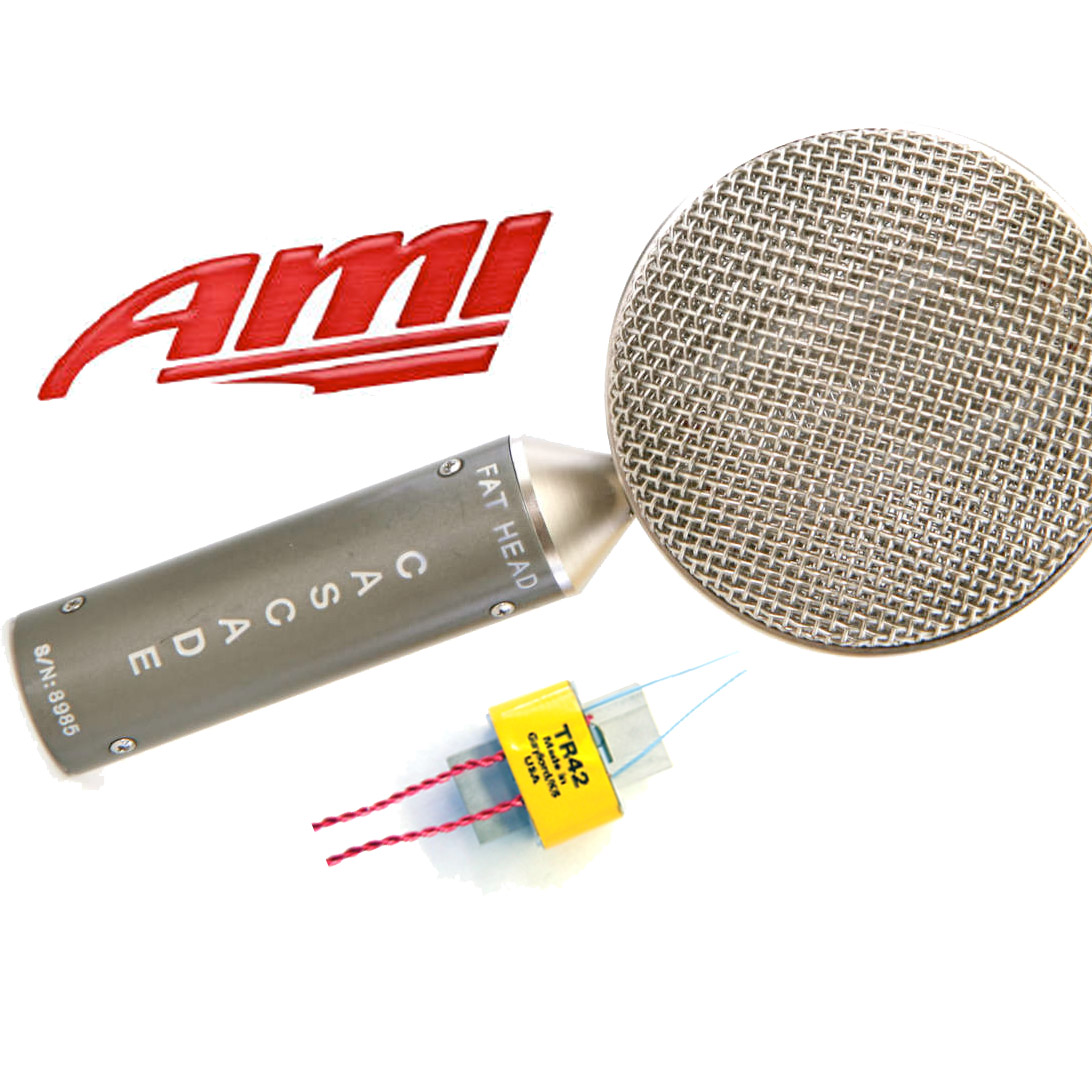
AKG D12VR Review
Monday, February 10th, 2014 | by Tony SanFilippo
I jumped at the chance to review AKG’s latest dynamic mic, the  D12 VR. I own a vintage D12e and I was quite curious about this mic. As many of you know the original D12 capsules are no longer available, so repairing a vintage model isn’t always an option. The new D12VR isn’t the same mic, though it does have some resemblances to the vintage model, both in looks and sound. I think the name D12VR (“Vintage Sound Reissue”) is a bit of a misnomer; as this is a new mic with a nod to a past model, maybe VR should mean “Vintage Re-imagination.” The original transformer is used in the new mic but there are many new, modern and pretty cool things going on.
D12 VR. I own a vintage D12e and I was quite curious about this mic. As many of you know the original D12 capsules are no longer available, so repairing a vintage model isn’t always an option. The new D12VR isn’t the same mic, though it does have some resemblances to the vintage model, both in looks and sound. I think the name D12VR (“Vintage Sound Reissue”) is a bit of a misnomer; as this is a new mic with a nod to a past model, maybe VR should mean “Vintage Re-imagination.” The original transformer is used in the new mic but there are many new, modern and pretty cool things going on.
 The D12VR is a dynamic microphone with an optional active filter system. The filter circuit requires phantom power, or can be bypassed if phantom power is disabled. This is a pretty clever system, and it works well. Phantom power does drop the mic’s output by 10dB, so you do need to adjust gain accordingly. A three-position switch on the mic’s top controls the filter. There is a bass boost with mid cut, mid cut only, and bass and treble boost with mid cut. Each is fairly easy to hear and can be useful in different situations. The switch has three LEDs, with one color per setting. I can see sitting in the control room, working on several songs with a band, and making simple decisions during tracking to change the mic’s settings on a per-song basis.
The D12VR is a dynamic microphone with an optional active filter system. The filter circuit requires phantom power, or can be bypassed if phantom power is disabled. This is a pretty clever system, and it works well. Phantom power does drop the mic’s output by 10dB, so you do need to adjust gain accordingly. A three-position switch on the mic’s top controls the filter. There is a bass boost with mid cut, mid cut only, and bass and treble boost with mid cut. Each is fairly easy to hear and can be useful in different situations. The switch has three LEDs, with one color per setting. I can see sitting in the control room, working on several songs with a band, and making simple decisions during tracking to change the mic’s settings on a per-song basis.
Kick Drum
My first test for the D12VR was bass drum, as that is the intended application of the mic. I set up a very simple hi-rez session in Pro Tools for just three mics: the D12VR inside my Yamaha Maple Custom Absolute 22'' BD, a Beyerdynamic M201 on snare and a single Octava MC012 (cardioid capsule) for overhead. The BD has a small pillow in it and a Powerstroke 3 batter head. Test one was with no filter, just the mic into my Neotek Elan console. The sound, like its vintage cousin (the AKG D12E) had a great attack. It’s almost what I always want my vintage model to sound like, defined but not pointy. It has great clarity. There isn’t a ton of low end, but the lows are there and sound good.
AKG D12VR, passive mode Vintage AKG D12ENext was filter position one, with bass boost and mid cut. This is a more modern sound. It adds a nice whoomp to the low end and softens the attack a tad. This is a sound that would probably requite less work in the mix phase, as it does what we often do to BD tracks anyway.
AKG D12VR, filter position 1The more extreme version is position three with the bass and treble boost, coupled with mid cut. This does add a lot of attack and cut to the sound. It might be useful in a very dense band to help the BD fight for sonic space.
AKG D12VR, filter position 3The middle position is mid cut only. I liked this sound, but it didn’t excite me the way the other two filter positions did. I also wish there were a filter without the mid dip. As all the positions have the mid cut, if it isn’t working for you, you need to go back to no-filter mode and get the added low and high elsewhere.
AKG D12VR, filter position 2I tracked an entire record for one of my bands: Steve Fast and his Calamities, with the D12VR in the bass drum. Unfortunately I was also the bass player on the session and I had our second guitarist manning the recorder. I decided to play it safe and keep the filter disengaged. I would have liked to try some different settings, but I needed my head in the playing game. I thought another project was going to come in shortly after my band’s, but then ended up postponing. I know I would have tried a few setting in context that way. As it sits the BD tracks do sound very good and are quite useful. I did notice that the D12VR takes well to processing. I can EQ different tones, and reshape the envelope nicely with compression.
Guitar Cabinet
On the same record I used the D12VR on a few guitar tracking overdubs. It was really wonderful to hear what the player was doing, simply engage phantom power, and try the different filters to see what fit in the track. The mid cut got some action on heavy guitars, and the bass and treble boost worked great for solos and more gangly parts. I believe the bass boost/mid dip made its way onto some things too. I loved having different tones without changing mics and cables.
D12VR on guitar cab, filter position 3 D12VR on guitar cab, filter position 3 plus compression D12VR on guitar cab, filter position 1Bass Cabinet
I was also able to use the D12VR on two different bass situations. The first is an acoustic band called Stripped by Hippies. The bass player has a “vertical electric” bass and favors a very dark, wooly tone. The sessions were spread out, so I had started with a  beyerdynamic M 88 on the bass, but used the D12VR on a later session. Even with the filters I was never able to get the presence that I wanted out of the D12VR. It was not a terrible sound, but on those songs the mixes will need a little more work than those cut with the M88.
beyerdynamic M 88 on the bass, but used the D12VR on a later session. Even with the filters I was never able to get the presence that I wanted out of the D12VR. It was not a terrible sound, but on those songs the mixes will need a little more work than those cut with the M88.
I also did a little re-amping on a Calamities song. I recorded the bass direct with a Purple Audio Action compressor. The amp was an Ampeg SVT III. I did a pass with each setting of the D12VR, as I did with BD above. The filter-less recording sound very close to the DI track; the bass boost, mid cut adds a nice weight. The mid cut tames the track a tad and the bass and treble boost adds some attack. We haven’t finished the track, so I’m not sure which I’ll use come mix time, but it will be fun to hear the options.
D12VR on bass cab, filter position 1 D12VR on bass cab, filter position 2 D12VR on bass cab, filter position 3 D12VR on bass cab, passive modeIn Use
Now a small gripe about the D12VR: The new model is smaller than the vintage and has a built in, threaded stand adaptor. I am generally a fan of mics with built in adaptors, as they make the age-old problem of missing mics clips go away. However, I don’t believe AKG did this particular version well. The mic only swivels one way, giving only 90° of rotation, not a full 180° that many mics with built-in adaptors do. The reason is that the threaded piece and the XLR output are molded together. The output is what blocks the mic from moving further. If the XLR was put 90° to one side, the mic could then move 180°. This is minor, but did force switching from a short desk stand to a boom on one session, when I would have preferred to just angle the mic down, but couldn’t. I also wish it was easier to know which end is the front of the mic. The mesh is pretty dense and I had to shine a light into the mic to see the diaphragm. I later realized that the limited rotation is another, easier way to determine the front of the mic.
I think the D12VR is a really interesting and cool mic. The active filter makes it pricier than many dynamic models, but I look at that feature as a worthwhile and useful addition.
Posted in Drums, Microphones, Reviews | 2 Comments »



cyjanopan
February 28th, 2014 at 4:31 pm
I am afraid that your vintage D12 is broken, I used few old ones and when they work properly they have a lot of LF, yours sound high-passed
Tony SanFilippo
March 7th, 2014 at 11:34 am
Yea, I think I blew my vintage D12 on a session. I need to send it to someone.